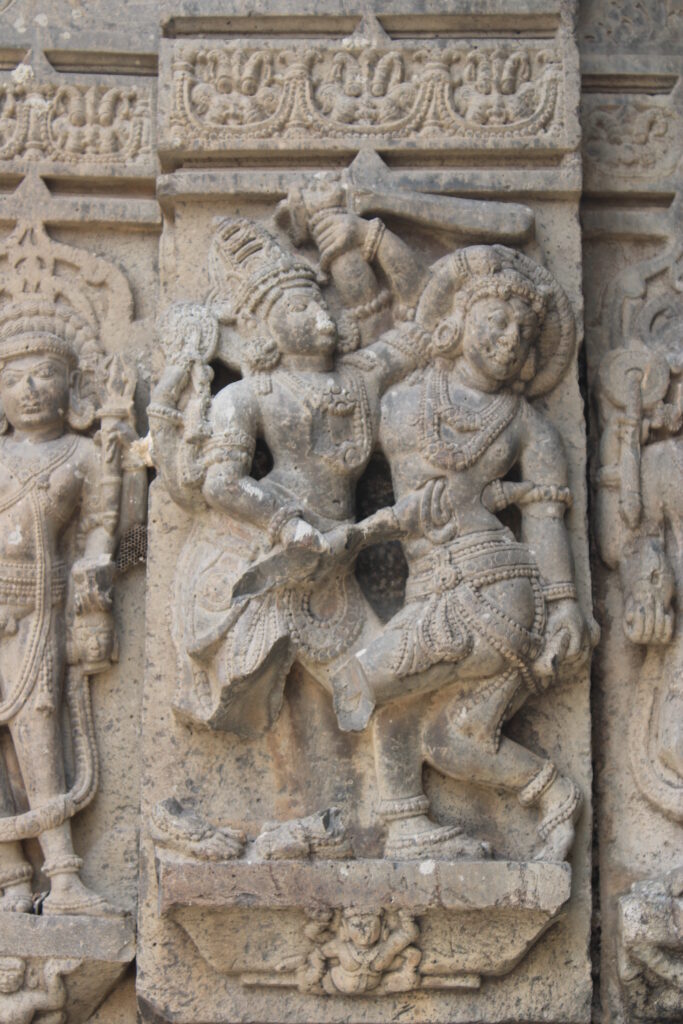Balarama, the elder brother of Krishna, does not find a lot of significance in worship today. However, he existed as a very significant figure in Bhagavata Purana. The elder brother of Krishna, he is described as the highest form of divinity that expanded into Vishnu. He is particularly significant in the Jagannath tradition, as one of the triad deities. In some traditions, he is also refered as one of the Dashavtaras of Vishnu.
He is also known as Haladhara, Halayudha, Baladeva, Balabhadra, and Sankarshana. The first two epithets associate him with hala (langala, “plough”) from his strong associations with farming and farmers, as the deity who used farm equipment as weapons when needed, and the next two refer to his strength.
Originally an agri-cultural deity, Balarama is mostly described as an incarnation of Adi Shesha, the serpent associated with the deity Vishnu; while some Vaishnava traditions regard him as the eighth avatar of Vishnu, with Jayadeva’s Gitagovinda (c.1200) “incorporat[ing] Balarama into the pantheon” as the eighth of the 10 principal avatars of Vishnu.

Balrama, killing Rukmi. Kedareshwara Temple, Dharmapuri, Maharashtra. 11th Century
Narratives of Balarama are found in Mahabharata, Harivamsha, Bhagavata Purana, and other Puranas. He is identified with the vyuha avatar of Sankarshana, along with the deities of Shesha and Lakshmana. In Mahabharata, Balram is described as the teacher who taught Gada yuddha and Kushti to Bhima and Yudhishthira. However, Balarama’s mythology and his association with the ten avatars of Vishnu is relatively younger and post-Vedic. Balarama finds a mention in Kautilya’s Arthashastra (4th to 2nd century BCE), where according to Hudson, his followers are described as “ascetic worshippers” with shaved heads or braided hair.
Balarama was anciently a powerful local deity named Samkarshana, associated with the local cult of the Vrishni heroes in Mathura from around the 4th century BCE. The concept of the avatars of Vishnu formed during the Kushan period in the 3rd to 2nd century CE. Coins dated to about 185-170 BCE show Balarama’s iconography and Greek inscriptions. At Chilas II in Pakistan (1st-century), are engraved two males along with many Buddhist images nearby. The larger of the two males hold a plough and club in his two hands. The early Balarama images found in Jansuti (UP) and two at Tumain (MP) are dated to 2nd/1st-century BCE and these show Balarama holding a Hala (plough) and a musala (pestle) in his two hands.
In all of these early depictions, Balarama seems to hold a senior position over Krishna. On the coins of Agathocles of Bactria, Balarama is on the front of the coin, whereas Krishna is on the reverse. At Chilas, Balarama is shown taller and bigger than Krishna. The same relationship is also visible in the hierarchy of the Vrishni heroes.
In some Indian ancient arts and texts, Balarama (Sankarsana) and Krishna (Vasudeva) are two of the five heroes (Pancaviras of the Vrishnis). The other three differ by the text. In some those are “Pradyumna, Samba and Aniruddha”, in others “Anadhrsti, Sarana and Viduratha”. The 1st-century Mora well inscription near Mathura, dated between 10 and 25 CE, mention the installation of five Vrishni heroes in a stone temple.
Balarama is depicted as light-skinned, in contrast to his brother, Krishna, who is dark-skinned; Krishna in Sanskrit means dark. His ayudha or weapons are the plough hala and the mace gadā. The plough is usually called Balachita. He often wears blue garments and a garland of forest flowers. His hair is tied in a topknot and he has earrings, bracelets and armlets; he is known for his strength, the reason for his name; Bala means strength in Sanskrit.
In the Jagannath tradition, one particularly popular in eastern and central regions of India, he is more often called Balabhadra. Balarama is one in the triad, wherein Balarama is shown together with his brother Jagannath (Krishna) and sister Subhadra (Subhadra).
The Jain Puranas, notably, the Triṣaṣṭiśalākāpuruṣacarita of Hemachandra, narrate hagiographical accounts of nine Baladevas or Balabhadras who are believed to be śalākāpuruṣas (literally torch-bearers, great personalities). Balarama was the ninth one. Balarama along with Krishna are considered as cousins of the revered Tirthankara Neminatha (Aristanemi) by Jains.
The story of Krishna’s life in the Puranas of Jainism follows the same general outline as those in the Hindu texts, but in details, they are very different: they include Jain Tirthankaras as characters in the story, and generally are polemically critical of Krishna, unlike the versions found in the Mahabharata, the Bhagavata Purana, and the Vishnu Purana. For example, Krishna loses battles in the Jain versions, and his gopis and his clan of Yadavas die in a fire created by an ascetic named Dvaipayana. Similarly, after dying from the hunter Jara’s arrow, the Jaina texts state Krishna goes to the third hell in Jain cosmology, while Balarama is said to go to the sixth heaven.
In other Jain texts, Krishna and Baladeva are stated to be a cousin of the twenty-second Tirthankara, Neminatha. The Jain texts state that Naminatha taught Krishna all the wisdom that he later gave to Arjuna in the Bhagavad Gita.
Balarama images have been discovered in central Indian Buddhist sites, such as with Sanchi stupas at Andher, Mehgaon and Chandna. These are dated to around the start of the common era. The Ghata Jataka, one of the Jataka Tales that form part of Buddhist scriptures, depicts Krishna as a previous birth of Buddha’s disciple Sariputta and has Balarama depicted as the previous birth of one of the Buddha’s disciples.
Balarama remains a largely unsung hero in almost all mythologies in India. But he definitely isn’t the only unsung one. In upcoming issues, we will know about more unsung heroes of religions and mythologies…!!!!
